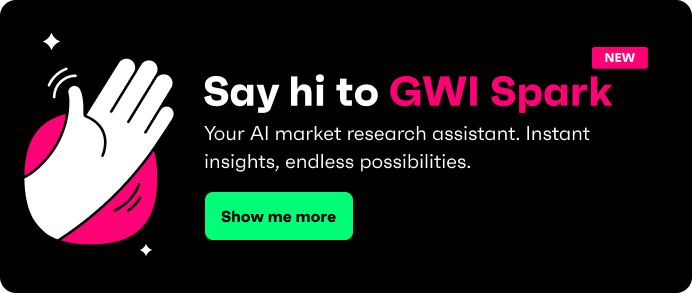
Let’s be honest: most brands say they want to really understand their audience. But in practice? They’re still relying on the usual suspects - age, gender, location, maybe some light behavioral data if they’re lucky. It’s enough to sketch a basic outline, but it’s nowhere near the full picture.
That’s where psychographics come in. They go beyond the “who” and get into the “why”. Why people think the way they do, what they value, how they live, and what actually drives their decisions.
It’s a crucial piece of the puzzle for any team trying to create products that people will love, campaigns that convert, or messages that click. For sales, media, and content teams, that level of insight can sharpen targeting, elevate creative, and close more deals. Cha-ching.
And with GWI Spark, tapping into that insight is faster, easier, and more scalable than ever. Instead of digging through reports or commissioning custom studies, teams can just ask and explore. Need to stress-test messaging with millennials who value sustainability? Just ask. Looking to understand what drives loyalty among Gen Z gamers? It’s just a few clicks away.
From demographics to desire: the power of going deeper
Demographics can tell you who your audience is. Behavioral data can tell you what they do. But neither explains why two people with the same job title, age, and income might respond differently to the exact same campaign.
That’s where psychographics earn their keep. They dig into what’s going on under the surface - the mindset behind the behavior, like personal goals, core values, and lifestyle preferences. Picture this: two people who look identical on paper. Same job, same age, same income, same city. But one spends weekends at yoga retreats, eats a plant-based diet and shops sustainably. The other’s first in line for the latest iPhone and eats most meals by using UberEats. On a spreadsheet they match, but in real life they couldn’t be more different.
Psychographics help you spot those differences and build strategies that actually connect.
GWI Spark helps fuse demographic, behavioral, and psychographic layers into one view, making targeting more meaningful and messaging more human.
Why psychographics are trending now
A few shifts have pushed psychographics to the forefront. For starters, consumers now expect brands to speak their language, both literally and figuratively. We’re in a moment where values matter. People are making choices based on purpose, identity, and emotion - not just features or price.
Combine that with the death of third-party cookies, and suddenly brands are scrambling for better, cleaner ways to understand their audience, and faster than ever.
At the same time, AI tools like GWI Spark are making it easier than ever to access this kind of data. So the question isn’t “why psychographics?”, it’s “why not?”
What psychographic research reveals: traits, values, and motivations
Psychographics tap into the stuff you can’t spot on a spreadsheet: personality traits, lifestyle choices, self-perception, core values, and personal desires.
Questions like “How do you see yourself?” or “What do you value most?” open up a whole new dimension of understanding. These answers shape everything from product preferences to brand loyalty.
GWI surveys ask direct questions like:
- How would you describe yourself?
- What do you value most in life?
- What do you desire from life?
- Which best describes your lifestyle?
These answers reveal more than just opinion. They shape how someone chooses products, engages with content, or builds brand loyalty, and you learn what really makes someone tick. GWI Spark brings these insights to life at scale, with no guesswork or gut calls, just real data from real people.
Active vs passive data: why psychographics demand direct input
Clicks and scrolls only tell you so much. They show what someone did, not why they did it. If you want to get to the root of someone’s thinking, you’ve got to ask them. Simple as that.
This is exactly where GWI Spark stands out. Its insights are built on responses from thousands of verified participants across more than 50 global markets, giving you up-to-date, scalable insight into what people actually think and feel.
Myths and misconceptions about psychographic research
Let’s clear a few things up:
- “Psychographics can’t be quantified.”
Wrong. With survey data, psychographic attributes are measured at scale and analyzed with the same rigor as demographics or behaviors. - “It’s fluff.”
Only if you’re doing it wrong. The best brands are using psychographic insights to shape product strategy, tighten campaigns, and win pitches.
- “Only researchers can use it.”
GWI Spark turns that idea on its head. Anyone can ask a question and get usable, visual insights in seconds, without an analyst on board.
So in reality, psychographics aren’t vague or inaccessible as some may think. They’re commercial, practical, and essential for teams who want to get ahead.
Use case spotlight: Sales, content, strategy
Sales teams are using psychographics to understand buying triggers and tailor their outreach. Content creators use them to find the emotional hooks. Strategy leads rely on them to stress-test product-market fit. Different teams, same challenge: they all want to know what actually motivates their audience.
Psychographics give them that. Whether it’s shaping outreach, building personas, or validating strategy, it’s insight you can use immediately.
With GWI Spark, each of these teams can explore psychographic data without needing a research background. It gives everyone you work with clarity on what your audience cares about and the confidence to make the moves.
From insights to impact: how psychographics boost performance
Whether it’s a media strategy built around lifestyle values or a product message tied to personal ambition, relevance drives results. Psychographics bridge the gap between insights and execution, helping you go from guessing to knowing, from generic to personal.
And when your strategy is aligned with what people actually care about, performance tends to follow. GWI Spark is that link between insight and action. It connects what you know, with what you do next.
5 high-impact ways to use psychographic research in your strategy
- Audience segmentation
Go deeper than demographics. Segment by mindset, motivations and values. - Persona development
Create richer, more human personas that reflect what drives decisions. - Channel planning
Understand not just where people are, but why - and how to meet them. - Creative development
Craft messaging that hits emotionally, not just functionally. - Product and brand strategy
Align what you’re building to what your audience really wants, from purpose to positioning.
Every one of these is faster and more actionable with GWI Spark. It supports you from early exploration to ready-to-export insights.
Psychographics in practice: what Bigeye got right
US-based agency Bigeye faced tough competition from larger firms. Their way in? Using psychographic research to build sharper, more persuasive audience profiles.
By weaving those insights into their pitches, they not only impressed clients, but they won even more business. They proved they understood audiences better than anyone else, and backed it up with real data.
Today, this approach is in their DNA, and it’s a playbook any brand or agency can follow.
GWI Spark: how to unlock psychographic insights in seconds
GWI Spark makes psychographic research accessible to everyone. No dashboards. No training sessions. Just a simple chat interface that delivers insights instantly.
It runs on GWI Core data across over 50 markets and offers tools to compare audiences, visualize results, and export them into decks or reports. Whether you’re building a campaign or refining a pitch, GWI Spark helps you get there faster.
And the best part? You don’t need to be a data expert to use it.
Quick checklist: Are you ready for psychographic insights?
- Do you know why your customers convert, or just who they are?
- Are you segmenting by mindset, or just by demographics?
- Are your campaigns struggling to feel relevant or personal?
- Do your teams have fast, reliable access to these kind of insights?
- Are you still guessing what’s relevant to your audience, and do you want to know?
If you answered yes to any of the above, it’s time to give GWI Spark a try.
Final thought: psychographics make the difference between guessing and knowing
At the end of the day, you can’t connect with people if you don’t understand what matters to them. Psychographics give you that edge: the difference between making noise and making impact.
With GWI Spark, any team can access those insights in seconds and start turning them into strategy, campaigns, or product decisions. Try it for your next pitch, persona, or content plan.
Because let’s face it: in a crowded market, relevance wins. The better you know your audience, the easier it is to speak their language and actually be heard.





.webp?width=495&height=317&name=pink_thumb_graphs%20(1).webp)
.webp?width=495&height=317&name=pink_thumb_letter%20(2).webp)